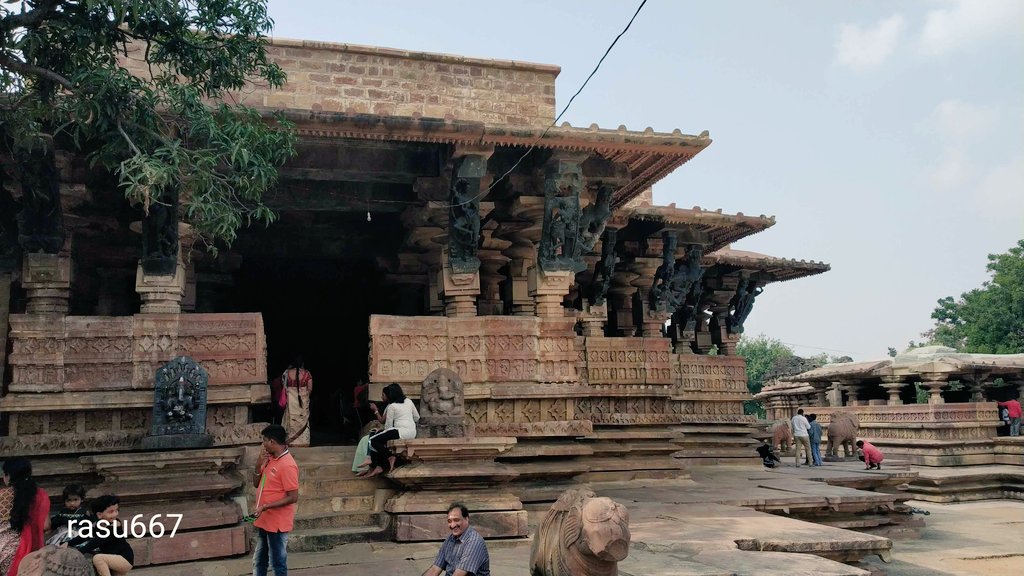
Sri Veera Venkata Satyanarayana Swamy - Annavaram.
#WalkToTemple
Annavaram Satyadeva kshetram is located on the Ratnagiri hills, East Godavari district, AP.
In 1891, a brahmin named Earanki Prakasam had a dream where Swamy instructed him to find his murti & install it.
#WalkToTemple
Annavaram Satyadeva kshetram is located on the Ratnagiri hills, East Godavari district, AP.
In 1891, a brahmin named Earanki Prakasam had a dream where Swamy instructed him to find his murti & install it.

That brahmin informed the then zamindar Sri Raja Ramarayanam of Kirlampudi estate of his dream & both of them along with other villagers searched and found the idol on the Ratnagiri hill. It was installed in a shed initially & later a temple was built. It was reconstructed in 

1933-34. Recently in 2011 it was reconstructed again.
I had had the darshan of Satyadeva 23 yrs ago. The temple looked a bit different then. I didn't go after 1997 for my own reasons & my family knew that it was not a preferred destination for me.
I was feeling sad bcs there was
I had had the darshan of Satyadeva 23 yrs ago. The temple looked a bit different then. I didn't go after 1997 for my own reasons & my family knew that it was not a preferred destination for me.
I was feeling sad bcs there was

no chance of going to Sri Rangam. I had thought to go to Parlakamundi & Meliaputti to have darshan at ancient temples. That too got cancelled.
On 22nd suddenly I heard a voice in my head 'Annavaram ra'. Since my husband had some work towards that side, I asked if he would take me
On 22nd suddenly I heard a voice in my head 'Annavaram ra'. Since my husband had some work towards that side, I asked if he would take me
He agreed to take me to Narsipatnam, from where we could go to Annavaram. I had already decided that if it was crowded I wouldn't go inside, yet had a hope it wouldn't be bcs I believe Satyadeva himself told me to come.
This is the kalyana Mandapam where marriages take place.

This is the kalyana Mandapam where marriages take place.


We saw 2 newly wedded couples fresh out of the ceremony. There is a hall for Satyanarayana Vratam bcs many people come here to get Vratam done. We saw 2, 3 families having the Vratam done when we were there.
We reached Annavaram at 8.30 am & too many people weren't there.
We reached Annavaram at 8.30 am & too many people weren't there.

We took a ₹100 ticket bcs we didn't want to risk being close to others. The temple is on two floors. Going directly upstairs we went to the antarala and had a beautiful darshan of Satyadeva, Ananta Lakshmi amma & Lord Shiva for 5 minutes. Pure uninterrupted bliss. 

Downstairs is the yantram of Deva.
The hall is big downstairs and we saw some pujaris sitting 10 feet away from one another, chanting. The whole atmosphere was divine. Bcs of the lesser crowd was able to see & appreciate every aspect so well.
Kalyana murtis look like this.
The hall is big downstairs and we saw some pujaris sitting 10 feet away from one another, chanting. The whole atmosphere was divine. Bcs of the lesser crowd was able to see & appreciate every aspect so well.
Kalyana murtis look like this.

Coming out we went to the Sun Dial. The Sun dial was built in 1943 by Raja Suryaprakash Rayani Bahadur & Brahma Sri Pidaparthi Krishnamurti Shastry. 







From there we come out & go to the Ramalayam. Sri Rama is the kshetra palaka of this temple. After having the divine darshan we came out and appreciated the surrounding. Because there were so few people it was possible for us to see everything and peacefully too. 







A Mandapam beside the Sri Ramalayam.
Going a level down, we reach the Vana Durga aalayam. Vana Durga amma is powerful and it is said she can be sometimes seen at night guarding the place.
I was told to do pradakshina to the place were Chandi Homan was done the previous day.

Going a level down, we reach the Vana Durga aalayam. Vana Durga amma is powerful and it is said she can be sometimes seen at night guarding the place.
I was told to do pradakshina to the place were Chandi Homan was done the previous day.


Pampa nadi is at the foot of the Ratnagiri hill.
There is a saying that when 1 door closes, another opens. I experienced that 3 days ago. For a person who didn't go for 23 years, to not only go, but to have blissful darshan is nothing but his krupa.
Om Satyadeva namostute 🙏
There is a saying that when 1 door closes, another opens. I experienced that 3 days ago. For a person who didn't go for 23 years, to not only go, but to have blissful darshan is nothing but his krupa.
Om Satyadeva namostute 🙏

• • •
Missing some Tweet in this thread? You can try to
force a refresh




































